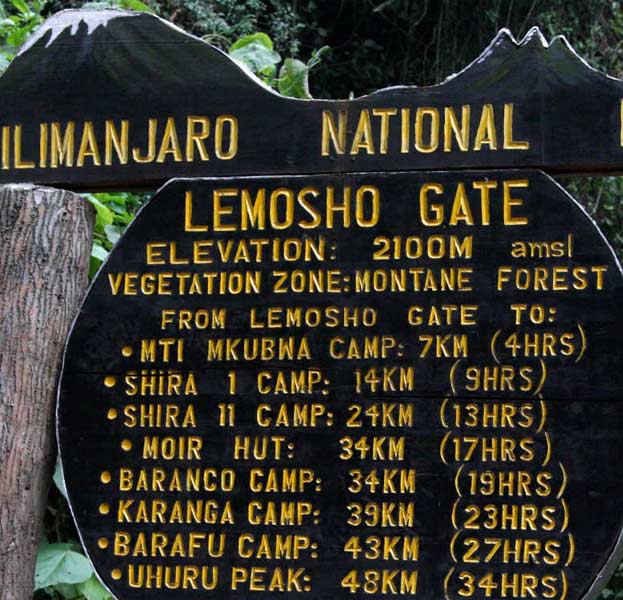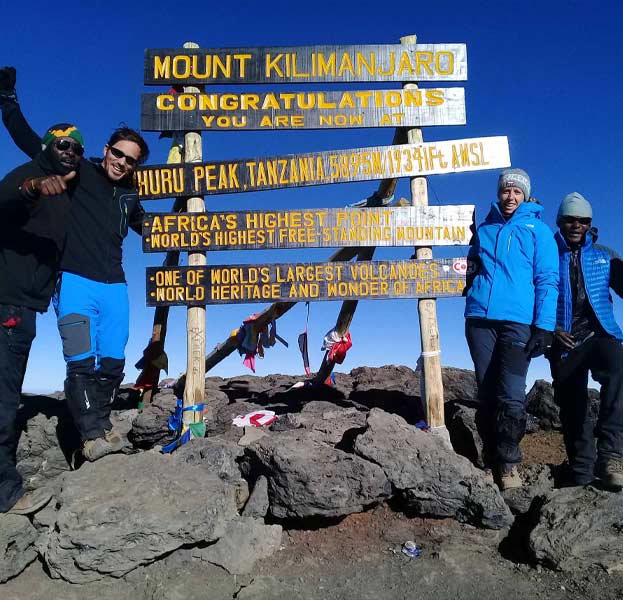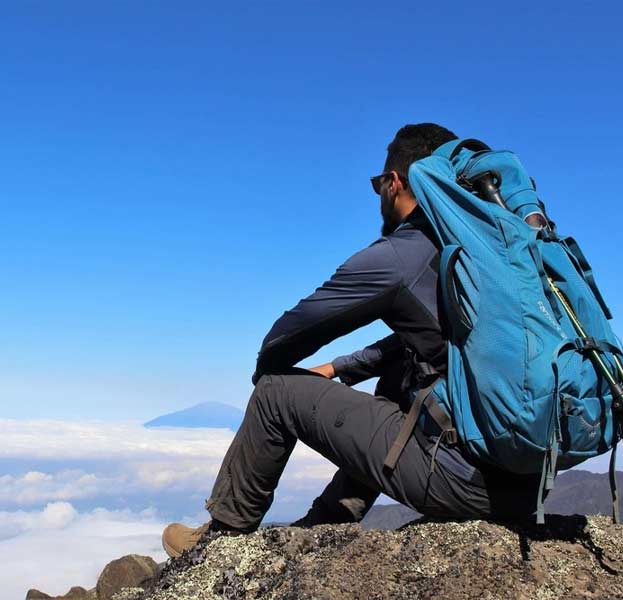Climb Kilimanjaro, the world’s tallest free-standing mountain and Africa’s highest peak
Mount Kilimanjaro is a place of myth and folklore. Located 200 miles (325 km) from the equator, the mountain defies logic with its crown of ice.
Climbing Kilimanjaro does not require any technical skills or special equipment, just some physical fitness and determination. People from all walks of life, from a 7-year-old child to an 89-year-old woman, have successfully summited. But the challenge should not be taken lightly. You need to understand what lies ahead.
Kilimanjaro Climbing Routes
You may climb the Mount by several routes, which have been established by the Tanzania National Parks Authority to avoid unauthorized Kilimanjaro hiking and preserve the pristine beauty of the wilderness for the generations to come.
We recommend Lemosho and Rongai routes for novices, Northern Circuit and Machame for the beginners, and Marangu and Umbwe for climbers with prior hiking experience. Camping on all routes except Marangu (where the night stops are in huts).

Lemosho Route
Lemosho is a slightly longer route, in the one of the preferred route due to its low traffic, beautiful scenery and high summit success rate.

Machame Route
Familiarity with the Excellency of Kilimanjaro with an acclimatization day on your trip to acclimatize to the roof of Africa. Digest with May that is

Marangu Route
For those that can’t sleep in a tent or using camp equipment in wettest season. This route will be the best decision (choice). Marangu route is a popular

Umbwe Route
The Umbwe route is the most challenge and difficult route to hike on Mount Kilimanjaro due to its steepness right from the beginning of the trek.

Rongai Route
Familiarity with the Excellency of Kilimanjaro with an acclimatization day on your trip to acclimatize to the roof of Africa. Digest with May that is the
Kilimanjaro Climb Guide
How much does it cost to climb Kilimanjaro?
Briefly, it does not take spending a fortune for a safe, comfortable and successful climb. However, the price below USD 1600 should alert you, as it is the first signal that your tour operator forsakes basic safety measures and hires semi-qualified (or unqualified altogether) guides and porters, who agreed to work for a pay far below the market average. Some tour operators do not pay their climbing crews at all, who sign up for the expedition relying on tips only.
In addition to that, “budget” a Kilimanjaro climb means poor diet, second-rate obsolete equipment and no operations in place. Thus, though embarking on a cheap trip may seem attractive financially, in reality, it jeopardizes your safety and perpetuates porter’s mistreatment.
Tanzania Tourism Safari offers various climbing packages that differ in pre- and post-climb accommodation and extra services and amenities on the Mount. However, each expedition of Tanzania Tourism Safari features the same safety standards and the same professionalism of our climbing crews.
Which route to choose for hiking?
There are several routes for climbing Mount Kilimanjaro.
Those seeking seclusion, scenic value and good acclimatization transition should consider Lemosho or Northern Traverse. A pocket-friendly and picturesque Machame provides good acclimatization transition, though it is a bit crowded during the high season.
Due to a popular misconception of being the easiest, Marangu route is the most popular and cheapest option. It is the only route providing hut accommodation (all other routes are camping only), which are handy for hiking Mt. Kilimanjaro during the rainy season. Marangu, however, features poor acclimatization and scenic value, as the trail is used for ascent and descent.
Rongai is one of the least crowded and the only route approaching the Mount from the North. It is a physically challenging option for Kilimanjaro hiking and is ideal for those who value remoteness. This route is recommended for hiking Kilimanjaro during the rainy seasons (Northern side of the Mountain protects the climbers from precipitation).
Umbwe route is the for the real adventurers. The steepest and shortest option to climb Mount Kilimanjaro, Umbwe is a challenging test of your endurance, stamina and determination. The route offers unique panoramic sceneries. The cost of that is, however, the weakest acclimatization transition.
Training to climb Kilimanjaro
Climbing Mount Kilimanjaro is a unique adventure because a person with average fitness level has high chances for reaching Peak Uhuru. The slopes of Kilimanjaro is the place where proper high-altitude acclimatization is more important than your endurance, stamina and strength.
However, we do encourage everyone, to take some workout. Not only will it help you to feel more comfortable on Kilimanjaro (some hikes are 10-14 km long), but also some sport is always good for your health overall.
Kilimanjaro Weather
Weather in Northern Tanzania is a good illustration of a typical tropical climate with a dry and a rainy season. The temperature rarely falls below C⁰ 25-35 (77- 95 F). March-May is the rainy season with high precipitation. November-beginning of December is the small rainy season. Check your luggage in accordance with our Kilimanjaro climb packing list.
Mount Kilimanjaro has a special temperature regime. Traversing five climatic zones, it features different temperatures, ranging from “hot” at the beginning of your trek to “very cold” (especially on the summit night, when the temperature may fall below 15 C⁰) in the summit areas. The closer you are to Uhuru Peak, the colder the air becomes. Rainfall and wildlife decrease progressively.
What is the Best Time to Climb Kilimanjaro
In short, you may climb Mount Kilimanjaro all year round. Climbs during the dry season are, however, more comfortable. The dry season spans the periods from the second half of from December till March and from June till November.
At the same time, a Kilimanjaro climb during the rainy season has some advantages as well.
Kilimanjaro Climbing Tips
For all those climbing Mount Kilimanjaro with us and with other tour operators, we have prepared the following insider tips:
- Climbing Mount Kilimanjaro is not about your level of fitness only. Determination, motivation and well-planned acclimatization transition are more important.
- Do not save up on your personal equipment. Branded high-quality clothes and sleeping bags often have decisive impact on successfulness of your climb. All personal equipment is available for rent in our office.
- Be ready to have no shower for a week or so. Portable showers are, however, available for extra fee.
- Public toilets may be uncomfortable, especially for the ladies. Thus, renting a portable toilet makes sense.
- Taking an mp3 player or an Ipod is a good idea. Enjoy the sceneries on the way and better preserve battery for the summit rush.
Kilimanjaro climbing FAQ
Mount Kilimanjaro in a nutshell:
| Location: | Kilimanjaro region, the United Republic of Tanzania |
|---|---|
| Geographic coordinates: | 03°04′33″S 37°21′12″E |
| Type of the mount | Stratovolcano |
| Altitude | 5,895 m/19,308 ft |
| First climb | Hans Meyer and Ludwig Purtscheller on October 6, 1889 |
| Climbs annually | Over 30,000 |
| Administrative authority | Tanzania National Parks Authority (TANAPA) |
How fit do you have to be to climb Kilimanjaro?
In short, ordinary fitness level is sufficient to reach the peak of Mount Kilimanjaro. If you can walk a 10-14 km/6-7 miles per day, certainly you can climb Mount Kilimanjaro.
Many websites recommend intensive training for climbing Mount Kilimanjaro. Our practice, however, showed that people with ordinary fitness level who got proper acclimatization always reach the summit. Yet, professional athletes, who failed to get acclimatized well (either because they “rush”, or because their guides fail to control their trekking progress) are at serious risk of high-altitude sickness and evacuation.
We do recommend you to take some exercises for your Kilimanjaro adventure. Good fitness level will always be a good advantage for a Kilimanjaro adventurer, as it will help you to tackle daily trekking challenge with ease and comfort.
If, however, for some reason you do not have an opportunity to take some workouts for your Kilimanjaro adventure – do not give up. Consider choosing a more extended program (such as Lemosho 8-day) with less daily trekking distance
How long does it take to walk up Kilimanjaro?
Depending on the route which you choose for your Kilimanjaro climbing adventure, it may take from 5 to 8 days. Longer programs with camping in Kilimanjaro crater are also available.
Do I need to have an insurance for Kilimanjaro trekking?
Though it is not a mandatory requirement for taking part in our Mount Kilimanjaro climb expeditions, we strongly recommend buying insurance against possible cancellation of your trip, lost and/or delayed luggage, emergency repatriation, emergency medical evacuation with helicopters.
Do I need to have a vaccination for Kilimanjaro expedition?
It is imperative to have a vaccination against yellow fever to enter Tanzania in case you are travelling to Tanzania from a country with risk of yellow fever transmission. In all other cases there are no immunization/vaccination restrictions to enter Tanzania.
For all those interested in getting more information we recommend reading our article Tanzania vaccination requirements.
Trekking, hiking or climbing?
Though three terms are often used interchangeably, there are some semantic differences. Hiking refers to the easiest type of leisure “walking” activities and implies that a hiker is walking by specially designated and adapted trails or human-made roads.
Trekking also refers to the process of walking, yet this concept implies that a “trekker” walks a longer distance than a hiker and exerts himself physically above ordinary level. Another noticeable difference is that trekking expeditions take place in the areas with no transportation.
The idea of “mountain climbing”, on the other hand, is fundamentally different from “hiking” or “trekking”. There are two distinguishing features of mountain climbing. Firstly, it means using special equipment (clothes and gear), which is not usually used for hiking or trekking expeditions. Secondly, the purpose of a climbing expedition is reaching the top of a mountain, while hiking and trekking may be practised in other wilderness areas.
Thus, semantically Kilimanjaro expeditions are both climbing and trekking. One-day Kilimanjaro adventures to the lower camps may be classified as “hikes”.
We at Tanzania Tourism Safari are tolerant to the conceptual differences and use all these terms interchangeably.
High altitude acclimatization for Kilimanjaro
In short, at 6000 m (19700 f) altitude the proportion of oxygen molecules in the atmosphere is substantially lower than at the sea level. It is discomforting for a human body, which is accustomed to getting certain amounts of oxygen.
We can get adapted to the shortage of oxygen molecules, but it is possible only when we progress upwards slowly to allow our body to make the necessary transformations in your respiratory system. Too fast ascent is the shortest way to HAPE and HACE, which are both life-threatening conditions.
Proper acclimatization is the most important aspect of a successful of a Mount Kilimanjaro climb.
